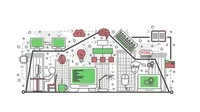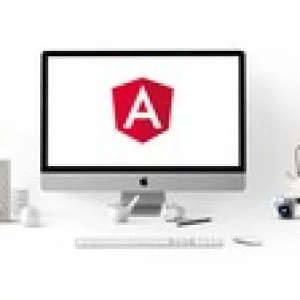
This tutorial teaches Angular using a project. So a simple customer screen is taken and around the same the whole course revolves. Remember the best way to learn any technology is by doing a project.
Below are complete details of the course :–
Chapter 1 :– Node and NPM
Chapter 2 :– Running first app & Angulr CLI
Chapter 3 :– VS Code editor.
Chapter 4 :– TypeScript
Chapter 5 :– CLI project folder structure
Chapter 6 :– The config JSON files
Chapter 7 :– ng serve vs ng build
Chapter 8 :– Angular the binding framework
Chapter 9 :– Component and Modules
Chapter 10 :– Expression , Decorators and TemplateURL
Chapter 11 :– Declaration and BootStrap in Modules
Chapter 12 :– The main.ts file for module startup
Chapter 13 :– Index.html and the selector tag
Chapter 14 :– Polyfills
Chapter 15 :– Webpack :– Packaging and deploying
Chapter 16 :– Vendor.js and Runtime.js
Chapter 17 :– Angular File naming Convention
Chapter 18 :– Creating Customer UI
Chapter 19 :– Creating Customer Model
Chapter 20 :– Consuming model in component
Chapter 21 :– ngModel , One way and Two way binding
Chapter 22 :– Expressions
Chapter 23 :– Understanding and Intrepeting Errors
Chapter 24 :– FormsModule
Chapter 25 :– *ngForLoop
Chapter 26 :– package.lock.json and versioning
Chapter 27 :– Using source code of the tutorial.
Chapter 28 :– Thinking Uniform , Thinking Master Pages
Chapter 29:– Creating Angular UI and its components.
Chapter 30 :– Organizing project folders, modules & components.
Chapter 31 :– Masterpage and selector
Chapter 32 :– Grouping components in to Modules.
Chapter 33 :– Understanding UI loading in selector.
Chapter 34 :– Routing and Routing collection
Chapter 35 :– router–outlet and routerLink
Chapter 36 :– RouterModule and loading routes in Angular.
Chapter 37 :– Understanding the flow of Angular with routing.
Chapter 38 :– Performance issues due to eager loading.
Chapter 39 :– Implementing Lazy loading
Chapter 40 :– Dividing project in to self contained Angular modules.
Chapter 41 :– Self contained routes for self contained modules.
Chapter 42 :– loadChildren :– The heart of lazy loading
Chapter 43:– Understanding path structure for folders and loadChildren.
Chapter 44:– forRoot and forChild
Chapter 45:– Multiple Modules , Multiple builds and Multiple outputs.
Chapter 46:– CommonModule for Lazy Loading
Chapter 47:– Seeing the physical separate modules in the dist folder.
Chapter 48:– Revising Angular architecture with Lazy routing
Chapter 49 :– Validation object model.
Chapter 50 :– Appropriate place to put validations
Chapter 51 :–Formgroup , FormControl , Validators and FormBuilder
Chapter 52 :– Using Angular validation :– The CCC process.
Chapter 53 :– Creating validations
Chapter 54 :– Applying validations to the UI
Chapter 55 :– Checking validation status
Chapter 56 :– ReactiveForms
Chapter 57 :– ngModelOption standalone
Chapter 58 :– Display errors for individual validations.
Chapter 59 :– The dirty flag.
Chapter 60 :– Centralizing validation code for reusability.
Chapter 61: – Definition of a good architecture
Chapter 62: – Concrete classes and tight coupling
Chapter 63: – Provider – provides things to component.
Chapter 64: – Creating providers: – Provide & UseClass
Chapter 65: – Interfaces issues with Angular DI
Chapter 66: – Finally understanding Dependency Injection
Chapter 67: – Seeing the actual fruits of Dependency Injection
Chapter 68: – Centralized and Conditional DI
Chapter 69: – Injector and tokens – Conditionnal DI
Chapter 70: – Dynamic collections
Chapter 71: – Revising Angular DI architecture
Chapter 72 :– Defining a user control
Chapter 73 :– Interactions :– Input, output and event emitters
Chapter 74 :– Creating user control and its components
Chapter 75 :– Creating user control component and importance of selector
Chapter 76 :– The @input decorator
Chapter 77 :– Stters and custom component naming convention
Chapter 78 :– Creating the Grid UI of the user control
Chapter 79 :– Defining output and event emitters
Chapter 80 :– Understanding the user control flow
Chapter 81 :– Importing and running the user control
Chapter 82 :– Debugging and watching the full flow.
Chapter 83 :– Json–server , the fake webserver
Chapter 84 :– Configuring json–server & db.json.
Chapter 85 :– importing and creating http component object
Chapter 86:– Making HTTP Post calls and the subscribe method.
Chapter 87 :– Import HTTP Module at the module level.
Chapter 88 :– Implementing DTO( Data transfer objects)
Chapter 89 :– Lambdas and Callback
Chapter 90 :– Angular HTTP Client.
Chapter 91 :– Using HttpClient
Chapter 92 : Simplicity of HttpClient.
Chapter 93:– Interceptors in HttpClient
Chapter 94:– The double data post
Chapter 95 :– Defining the scope of the tutorial.
Chapter 96 :– Using Angular template and its limitation
Chapter 97 :– Respecting individual build and compilation.
Chapter 98 :– MVC wwwroot folder and Angular
Chapter 99 :– Issues with ng serve and integration
Chapter 100 :– Bootstrapping through MVC
Chapter 101 :– Deployurl concept.
Chapter 102 :– Integrating Webapi with Angular Http
Chapter 103 :– Debugging Angular and MVC
Chapter 104 :– Ahh the camel case and pascal case issue
Chapter 105:– Integrating Grunt with Task runner explorer
Chapter 106 :– Grunt configuration using appsettings.json
Chapter 107 :– Prebuild and Postbuild style
Chapter 108 :– Double tooling VS code and Visual studio
Chapter 109 :– Create new project using ng new command.
Chapter 110 :– Copy the code in to newly created projects.
Chapter 111 :– Run ng serve , fix errors http to httpclient
Chapter 112 :– Test and you are all set
Chapter 113 :– Integration testing vs Unit Testing
Chapter 114 :– Black Box vs White Box
Chapter 115 :– Jasmine and Karma
Chapter 116 :– Understanding Jasmine syntaxes , BDD , Describe and it.
Chapter 117 :– BeforeEach,BeforeAll,AfterEach and AfterAll
Chapter 118 :– The TestBed API
Chapter 119 :– Angular loading flow.
Chapter 120 :– Fixture the baseline.
Chapter 121 :– DebugElement , componentInstance and nativeElement
Chapter 122 :– Assertion – expect , tobeTruthy , toEqual
Chapter 123 :– Synching DOM’s DetectChanges.
Chapter 124 :– QuerySelectors.
Chapter 125 :– Running Angular test
Chapter 126 :– Writing a complex unit test for the Customer screen
Instructor Details
Courses : 5
Specification: Angular Step by Step for beginners
|
18 reviews for Angular Step by Step for beginners
Add a review Cancel reply
This site uses Akismet to reduce spam. Learn how your comment data is processed.

| Price | $14.99 |
|---|---|
| Provider | |
| Duration | 8 hours |
| Year | 2020 |
| Level | Beginner |
| Language | English |
| Certificate | Yes |
| Quizzes | Yes |

$19.99 $14.99






Akshay Bhatnagar –
As I am a beginner in angular. This tutorial helps me to understand the basics and advance the concept of angular. I am hoping the future lectures are more interesting
Kundan yadav –
nice
Aleksey Ulitsky –
Excellent, but unfortunately, some peaces of code are not working for me. But anyway, the course is really cool!
Pooja Singh –
Begining videos are good. Labs get little complicated while coming towards Lab 7 and 8 since too much information is provided in one lab itself. Also there is no lab for integrating angular with Java. So lab 9 was not useful for me since I come from Java background.
Navina.M –
Very good tutorial.. Exact to the point?
Srikanth –
good
Preeti Bajpai –
Hello Sir , I am really thankful to you for making this tutorial. It s really a very good tutorial. I like your explanation.
Brenda Mariner –
A little hard to understand instructor.
Nazima SUltana –
good
Ganesha Shettigara –
All the concepts explained very well. But wish it was a bit more deep into concepts.
Iva Korlevic –
not prepared well and confusing
Jacqueline Haefke –
I can’t see the screen. It has not always the same resolution
Mrinal Ghosh –
still not so understandable, not for beginners and also experienced.
Tandrima Sarma –
Very well explained from base
Mrinal Ranpise –
nicely explained
Harikrishnan –
Course have not updated! The content or files attached are not useful now.
Jon Weimer –
He starts from the very beginning and assumes you know nothing and then walks you through the steps in a very linear order which is very easy to follow.
Zaab Weldegebrial –
It is perfect so far